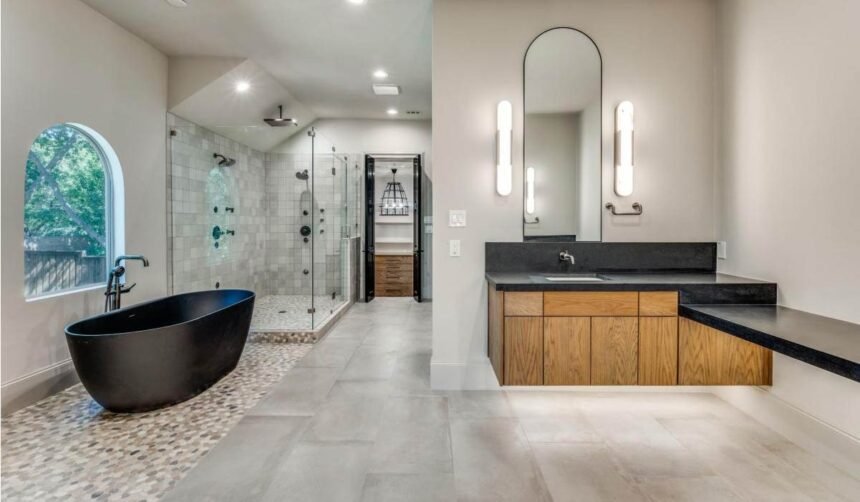In the modern home, every room serves a purpose—but some play a more intimate and essential role in daily routines than others. The bathroom, once a purely functional space, has evolved into a personal retreat, a place of comfort, rejuvenation, and reflection. As priorities shift toward wellness, convenience, and design, bathroom remodeling has become one of the most impactful home improvement projects a homeowner can undertake.
Whether it’s a full-scale renovation or a few strategic updates, a well-executed bathroom remodel can transform how a space is used and experienced. From enhancing aesthetics to improving functionality, energy efficiency, and even property value, the benefits are broad and long-lasting.
In this article, we explore the reasons homeowners invest in remodeling their bathrooms, the latest design trends shaping today’s renovations, the remodeling process itself, and tips for getting the most value out of your investment.
Why Homeowners Prioritize Bathroom Renovations
Unlike a living room or bedroom, which may serve multiple or interchangeable purposes, the bathroom is a necessity. It’s used daily, often multiple times a day, by every person in the household. As such, issues like outdated design, poor layout, and insufficient storage are not just annoyances—they affect daily life. Here’s why many homeowners are prioritizing updates to their bathrooms:
1. Functionality First
A poorly designed bathroom can make even the simplest routines frustrating. Whether it’s a lack of counter space, awkward plumbing placement, or inadequate lighting, functionality is a key motivator for renovations.
2. Modern Design Appeal
Style trends in bathrooms have changed dramatically over the years. Homeowners often seek sleek, modern aesthetics with clean lines, neutral tones, and premium finishes to replace dated bathroom tiles, old fixtures, or worn-out vanities.
3. Energy and Water Efficiency
New technologies in toilets, faucets, and lighting can significantly reduce water and energy usage. Upgrading to energy-efficient fixtures can help save money on utility bills while benefiting the environment.
4. Improved Storage Solutions
A cluttered countertop can make even a beautiful bathroom feel disorganized. Innovative cabinetry and built-in storage are common upgrades in bathroom remodels to maximize usable space.
5. Increased Home Value
Real estate data consistently shows that bathroom remodeling offers a high return on investment. Updated bathrooms are major selling points and can help homes sell faster and at higher prices.
Planning Your Bathroom Remodel: Key Considerations
Any remodeling project begins with proper planning. Bathrooms, in particular, require special attention to plumbing, moisture control, and space utilization. Before the first tile is laid, here are a few critical decisions to make:
Set Your Budget
Establish a clear budget that includes both materials and labor. Don’t forget to allocate extra (typically 10–15%) for unexpected issues that may arise once work begins.
Define the Scope
Are you looking to refresh the space with cosmetic changes, or do you need a full gut and rebuild? Understanding the scale of your project will guide design and material choices.
Prioritize Needs vs. Wants
List must-have features (e.g., more storage, better lighting) and secondary items (e.g., heated floors, luxury finishes) to stay on track financially and functionally.
Choose the Right Professionals
Hiring an experienced contractor or designer ensures your vision can be translated into reality while avoiding costly mistakes. A professional will also manage permits, inspections, and subcontractors.
Current Trends in Bathroom Design
Design trends continue to evolve, and today’s bathroom is all about blending style with wellness. Here are some of the most popular trends that are redefining how bathrooms are being remodeled:
1. Spa-Inspired Spaces
Think rain showers, soaking tubs, calming color palettes, and ambient lighting. The goal is to recreate a luxurious, spa-like atmosphere for relaxation and stress relief.
2. Floating Vanities and Wall-Mounted Fixtures
These design elements offer a sleek, modern look and create the illusion of more space—ideal for small or narrow bathrooms.
3. Natural Materials
Stone, wood, and textured tiles are being used to bring warmth and organic beauty into the bathroom environment.
4. Matte Finishes and Mixed Metals
From faucets to hardware, matte black, brushed nickel, and gold finishes are being mixed for a bold, contemporary effect.
5. Smart Technology
Voice-activated lighting, touchless faucets, heated floors, and smart mirrors are turning bathrooms into tech-friendly zones of comfort.
The Process of Bathroom Remodeling: Step-by-Step
Understanding the typical flow of a remodeling project can help reduce stress and set realistic expectations.
1. Consultation and Design
Work with your contractor or designer to discuss your goals, layout, style preferences, and budget. This stage may include 3D renderings or detailed sketches of the finished space.
2. Material Selection
Choose fixtures, tiles, lighting, cabinetry, and other finishes. Selecting materials early helps avoid delays during construction.
3. Demolition
The existing bathroom is gutted, removing old tile, fixtures, and cabinetry. This is often noisy and dusty but is a necessary step in the process.
4. Plumbing and Electrical Work
Behind-the-scenes work is completed, including rerouting plumbing, adding new electrical lines, and upgrading ventilation if needed.
5. Structural Work and Installation
Walls may be reframed or moved, new drywall is installed, and waterproofing measures are applied in wet zones.
6. Tiling and Fixtures
Tiles are laid, and fixtures such as toilets, sinks, showers, and tubs are installed.
7. Finishing Touches
Painting, mirrors, lighting, and accessories are added to complete the look.
8. Final Inspection and Cleanup
A thorough inspection ensures all work complies with codes and standards. Then the space is cleaned and ready for use.
Common Challenges and How to Avoid Them
Even the most well-planned project can face obstacles. Here are some common issues and ways to prevent them:
- Hidden Water Damage: Older bathrooms may have mold or rot behind walls. A thorough inspection during planning can help identify issues early.
- Scope Creep: It’s easy to get carried away adding upgrades. Stick to your plan and budget to avoid unexpected costs.
- Scheduling Delays: Availability of contractors or materials can slow progress. Build flexibility into your timeline.
- Poor Lighting Choices: Insufficient or harsh lighting can ruin an otherwise beautiful space. Opt for layered lighting with dimmable options.
How to Get the Most Value From Your Remodel
A successful bathroom remodeling project is one that not only looks good on day one but continues to serve your needs for years. Here are tips to ensure lasting satisfaction:
- Choose Timeless Over Trendy: While it’s tempting to follow the latest fads, classic design elements will keep your bathroom looking fresh and valuable over time.
- Invest in Quality Materials: Bathrooms are exposed to moisture daily. Durable, water-resistant materials will stand the test of time.
- Think About Aging in Place: Features like grab bars, walk-in showers, and non-slip flooring are becoming more common—even in homes without elderly occupants.
- Focus on Storage: More drawers, open shelving, and hidden compartments can help keep the space tidy and functional.
Final Thoughts
A bathroom may be one of the smallest rooms in the home, but it can make one of the biggest impressions. Whether you want to create a relaxing oasis or simply make your daily routine more efficient, bathroom remodeling is a worthwhile investment in comfort, functionality, and value.
By planning carefully, staying within budget, and working with the right professionals, you can create a space that not only looks stunning but serves your household well for years to come. Don’t underestimate the power of a well-designed bathroom—it’s not just a space you use; it’s a space that enhances how you live.









